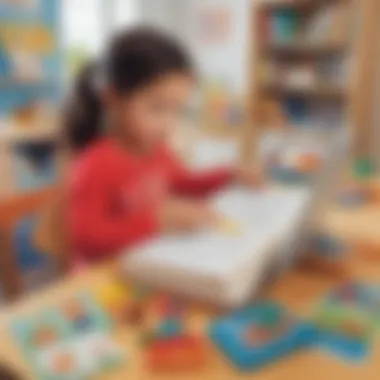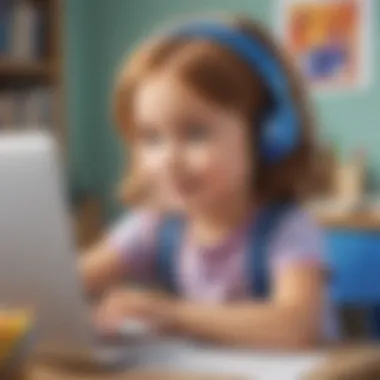Discovering Free Online Resources for Preschool Education


Intro
In today’s digital age, children are often introduced to many forms of content. Among the most beneficial pathways for preschool-aged children include various online educational resources. With growing accessibility to the internet, free preschool educational websites stand out. These sites provide engaging environments for young learners, where play and learning coexist seamlessly.
Within this exploration, we dissect multiple platforms designed for early education, examining their interactive features and overall effectiveness. The impact of these platforms goes beyond entertainment, offering substantial educational value that can enhance childhood development.
Creative Activities
Creative engagement is essential for preschoolers, as it aids their development and cognitive skills. Many free preschool educational websites offer a variety of creative activities that foster creativity and learning.
Craft Ideas
Websites like Sesame Street and PBS Kids feature numerous craft ideas, ranging from simple paper crafts to more complex art projects. These ideas are designed for children to carry out with minimal parental guidance.
Step-by-Step Guides
Detailed instructions attached to each craft activity ensure that children can follow along easily. Many platforms show illustrations or videos that guide the crafting process clearly, enabling young children to grasp instructions effortlessly.
Educational Value
Engaging in art not only hones a child’s motor skills but also establishes connections with concepts such as color theory, shape recognition, and design.
Fun Quizzes
Interactive quizzes on educational websites help reinforce knowledge through play. Topics covered range from numbers and letters to science and nature.
Quiz Topics
ElemFun, for example, provides quizzes that encourage exploration in various subjects including music, animals, shapes, and the seasons. This diversity ensures a broad spectrum of learning experiences.
Question Types
Quiz formats vary, often including multiple-choice questions, fill-in-the-blank activities, and matching games. This diversity captures children's attention better than simple Q&A styles.
Knowledge Reinforcement
This fun approach to learning can greatly improve information retention. Engaging quizzes aide children in connecting new knowledge to their existing understanding.
Fact-Based Articles
Many preschool educational websites include articles that cover engaging and informative topics targeted for young children. These written pieces deliver knowledge in a fun and relatable manner.
Topics
The articles serve a range of subjects such as animals, weather, health, and transport. Such variety cultivates a child's curiosity and desire to learn more.
Engaging Content
Fact-based articles present this information in a way that is straightforward yet interesting. With the use of visual aids and simple language, children easily absorb complex ideas.
Preamble to Free Preschool Educational Websites
Preschool education acts as the foundation of a child's learning journey. With the rise of digital technology, free websites designed specifically for preschoolers provide rich resources for children, parents, and educators alike. These platforms offer a distinctive blend of play and learning, making education accessible in ways that traditional methods may not achieve.
In this new era of education, understanding the scope and advantage of free preschool educational websites is crucial. The benefits of these resources include flexibility and availability. Children can access engaging content anywhere and anytime. This convenience helps to extend learning beyond the conventional classroom setting, allowing for a continuous educational experience.
Some major considerations arise from using these resources. Not every website meets high educational standards. Hence, parents and educators should evaluate the content thoroughly. Looking for interactive features, attractive interfaces, and alignment with educational benchmarks is vital to ensuring the child's best learning outcomes.
Defining the Preschool Age Group
The preschool age group typically includes children aged three to five. During these formative years, children undergo significant cognitive, emotional, and social growth. Understanding the characteristics of this age group is essential when selecting the right educational resources for them.
At this stage, children are naturally curious, eager to learn new skills, and engaged in social interactions. They also begin developing motor skills, language abilities, and essential cognitive concepts. This makes preschool a critical period for fostering a love for learning and creating a good foundation for future education.
The Importance of Early Childhood Education
Early childhood education plays a pivotal role in shaping children's future. It is widely recognized that the experiences children have before entering formal school can directly influence their academic success later on. Accessing educational websites can be an effective fireld for providing quality learning opportunities.
The key aspects of early education include:
- Promoting cognitive development
- Encouraging social skills
- Enhancing emotional intelligence


Research suggests that interventions during early childhood have lasting impacts. Engaging them with structured, yet fun, content helps build their confidence and self-esteem. Also, children are more likely to develop positive attitudes toward education when they engage in interactive and enjoyable learning.
Conclusion: This comprehensive approach when utilizing free educational websites can significantly aid both children and educational stakeholders in realizing enriched learning experiences. Properly implementing these resources can effectively elevate the level of preschool education.
Key Features of Successful Educational Websites
When evaluating free preschool educational websites, understanding their key features is crucial for informed decisions. These features not only contribute to user experience but also engage young learners effectively. They determine how well a website can support educational goals for preschool-aged children.
User-Friendly Interfaces
A user-friendly interface serves as a critical element for preschool educational websites. Young children, while inquisitive, often have limited reading comprehension skills. Thus, navigating any digital platform should rely not on text-heavy instructions, but intuitive design. Buttons should be icons or images, easy to understand and recognize.
Elements like large touch targets and vibrant colors can keep children engaged. Easy access to content is vital. Also, parents and educators should find it straightforward to identify necessary information.
Moreover, consistency in layout and design helps reinforce familiarity. When children return to the site, noticing the same colors and element placements aids self-guidance in using the platform. This comfort encourages exploration and learning.
Interactive Learning Activities
Another key feature of effective preschool websites is the inclusion of interactive learning activities. These activities must go beyond simple content consumption. Instead, they should promote active participation, facilitating engagement. Games, quizzes, and puzzles designed for preschoolers, empower children to learn through doing.
Whether it is solving a counting game or participating in a digital storytelling session, these interactions can embody several learning theories. For instance, hands-on activities help develop fine motor skills along with cognitive capabilities.
This enables immediate feedback. Children gain the opportunity to correct errors in real time, understanding concepts organically in the process. Websites that incorporate such activities capture preschool interest, making learning enjoyable while reinforcing educational goals.
Alignment with Educational Standards
Alignment with educational standards is crucial for ensuring content quality and relevance. Websites that meet, and can demonstrate adherence to established educational benchmarks can offer more than engaging material; they provide accountability. These standards guide content creation and assure parents or guardians of the material's educational value.
Actively seeking websites dedicated to state or national standards is beneficial. It means the content is made preferably in line with learning objectives for early childhood. Websites like PBS Kids, for example, often openly advertise their dedication to educational readiness.
Furthermore, maintaining focus on such alignments often leads to robust, comprehensive learning paths that set young learners up for future successes in more formal early education settings.
Educational Websites Tailored for Preschoolers
In today's digital world, educational websites designed for preschoolers play a crucial role. These platforms offer interactive, age-appropriate content that boosts early intellectual development. They provide resources that parents and educators can use to stimulate learning beyond traditional classroom settings. Websites designed specifically for preschool-aged children contribute to a holistic approach in nurturing cognitive and social skills.
Overview of Noteworthy Websites
Several websites are notable for their contribution to preschool education with unique features:
- Starfall: This site focuses on phonics, reading, and mathematics. Starfall provides an engaging environment where children learn through songs and stories, effectively keeping their interest.
- PBS Kids: Known for its popular characters, this site offers a mix of games, videos, and educational activities. Each game reinforces knowledge while encouraging skills like critical thinking and problem-solving.
- ABCmouse: It offers a comprehensive curriculum covering multiple subjects. With a subscription model, it has guided paths that lead children from basic concepts to more complex subjects of learning.
- Scholastic Learn at Home: This platform offers themes each week, including various activities. Parents and teachers find it easy to navigate and use, making it valuable for enrichment.
The central theme across these sites is engagement. Young children often respond better when they are involved actively in learning. With visually pleasing interfaces and entertaining characters, these sites make education enjoyable.
Comparison of Features and Benefits
Different websites cater to various needs and interests. It's useful to examine these offerings to make informed choices.
- Interactivity
- Diverse Content
- Parent Guides and Resources
- Many platforms feature games that allow for direct responses from toddlers. Options like puzzles or language games help to develop hand-eye coordination and problem-solving abilities.
- Each site combines elements of storytelling, music, and art. Websites like PBS Kids pair fun with unique learning experiences, helping children explore imagination alongside education.
- Sites like ABCmouse provide guides for parents. These options can help adults understand how to best use online resources for enhancing learning.
This variety across different websites indicates the commitment to providing valuable tools for educators and parents. The combination of interactivity, content diversity, and supportive resources enriches the educational landscape for preschoolers.
In summary, educational websites dedicated to preschoolers offer a robust foundation for learning. They cater to the unique needs of this age group, making them an essential tool for early education.
Types of Learning Content Available
The availability of various types of learning content is crucial in the context of preschool education. This ensures that children gain a holistic understanding and enjoyment of learning. Educational websites designed for preschoolers cater to multiple facets of child development, promoting creativity, cognitive skills, and emotional growth. Different formats engage children uniquely, enabling deeper connections to educational material.
Interactive Games and Quizzes
Interactive games and quizzes serve as vital tools for engaging preschool-aged children. These activities not only capture children's attention but also foster critical thinking and problem-solving skills. Kids can explore numbers, shapes, and letters through entertaining challenges, making learning feel like play rather than a task.
Moreover, such games encourage self-paced learning. Children can attempt questions repeatedly until mastering the concepts. This positive reinforcement aids understanding, allowing children to gain confidence as they progress.
Key benefits include:
- Active participation: Games stimulate participation, keeping children interested.
- Immediate feedback: Instant results help young learners understand mistakes and correct them without frustration.
- Cognitive development: These games often employ elements that enhance memory and tactical thinking.


Storytelling and Reading Resources
Storytelling and reading resources play an essential role in language development and comprehension for preschoolers. These interactive platforms introduce children to new words, phrases, and sentence structures systematically. Simple narratives feature already relatable characters and scenarios, which makes connections to children's experiences.
Resources often include interactive ebooks that read aloud to kids. When combining visual elements with narration, children absorb information while maintaining interest. Furthermore, these resources promote a love for reading, which lays a strong foundation for future learning.
The advantages of storytelling and reading resources encompass:
- Enhancing vocabulary: Regular exposure to new words boosts language skills.
- Emotional comprehension: Characters facing challenges help children understand complex emotions and situations during learning.
- Cognitive skills: Stories stimulate imaginative thinking and improve memory as children recall plots and character interactions.
Creative Arts and Crafts Activities
Creative arts and crafts activities form an integral part of learning at the preschool level. They provide opportunities for kids to express themselves while exploring their creativity in various formats. Engaging in hands-on activities allows children to improve fine motor skills while learning about colors, shapes, and textures.
These pastimes also foster problem-solving abilities as children decide how to represent their ideas visually. They may decide that a triangle becomes a roof and circles become wheels. Such decisions encourage critical thinking.
Notable benefits include:
- Creative expression: Children learn to articulate their emotions through art, promoting mental well-being.
- Physical coordination: Arts and crafts tutorials build hand-eye coordination through interactions with different tools and materials.
- Cognitive development: These activities allow for exploration of patterns, concepts, and themes relaxed through a creative lens.
Combining diverse learning content enhances engagement and promotes a well-rounded learning environment. When children experience a variety of activities, they gain a deeper understanding of the material as they learn and grow.
Evaluating the Effectiveness of Educational Websites
Evaluating the effectiveness of educational websites is essential in determining whether they truly benefit preschool-aged children. This section highlights relevant elements that contribute to their success. Successful assessment ensures that these online platforms fulfill their educational goals while engaging young learners effectively.
Measuring Engagement and Learning Outcomes
Measuring engagement and learning outcomes provides insight into how well educational websites capture children's interest. Engagement can be monitored through various metrics:
- Time spent on activities: A longer duration may indicate that children find the resources enjoyable and meaningful.
- Completion rates: Products with higher completion rates suggest that content is accessible and not frustrating for children.
- Interaction levels: The friendly user interfaces and interactive elements can improve student involvement.
Outcomes are trickier to quantify but can be measured using:
- Pre and Post Tests: Testing a child's skills before and after using a site can reveal improvements.
- Skill development milestones: Tracking progress in areas like numbers, letters, and basic problem-solving is critical.
- User-generated feedback: Input from parents helps understand the effectiveness of activities beyond mere metrics.
By focusing on engagement and measuring outcomes, stakeholders can align their efforts with children's learning experiences. It fosters an environment where preschool children can thrive in understanding fundamental concepts.
Feedback from Educators and Parents
Feedback from educators and parents serves as a significant component in evaluating the suitability of preschool educational websites. Their insights can provide details about how well resources address children's needs:
- Pragmatic observations: Educators often observe real-time engagement and may spot areas that require improvement.
- Success stories: Testimonials about a child's progress can illustrate a product's utility.
- Concerns or complaints: Negative feedback may highlight limiting factors of a resource, such as interface issues or cultural sensitivities.
Understanding parental perspectives is equally valuable. Parents can offer viewpoints on usability and how resources integrate into daily routines. Surveys can grasp user experiences and satisfaction levels. Furthermore, forums like Reddit often discuss various educational platforms and reveal collective insights that may otherwise go unnoticed.
Assessing feedback continuously supports refinement, ensuring educational websites evolve to meet the preschool audience's ever-changing demands. Collectively, both educators and parents play a vital role in evaluating these essential tools, helping to shape a quality experience for young learners.
Accessibility and Inclusivity in Learning
Accessibility and Inclusivity in learning materials are crucial for a successful educational experience for preschool children. As more resources become available online, it becomes essential to ensure that these tools can meet the diverse needs of all learners. This section explores critical elements, benefits, and considerations that make educational websites more accessible and inclusive for preschoolers.
Addressing Diverse Learning Needs
Individual learning styles vary greatly among children, especially in preschool years. Children may have preferences for visual, auditory, or kinesthetic learning modalities. To cater to this diversity, educational websites should incorporate a mix of content formats. For instance:
- Visual videos and images for visual learners.
- Audio storytelling for auditory learners.
- Interactive games that require movement or manipulation for kinesthetic learners.
By offering diverse content, these platforms can engage all kinds of learners. Additionally, applications can introduce features like adjustable text sizes and color contrast, which help children with visual impairments access the same material, it enhances learning experiences significantly.
Language Options for Multilingual Families
In today’s diverse world, many families prep their children to be bilingual or multilingual at a young age. The functionality for multiple languages in educational websites supports these families adequately. It allows preschoolaged children to interact with educational materials in their first language while learning a new one too.
Websites that provide language options could gravely benefit from using headings to classify content, thus assisting guardians and educators in this navigation. Specifically, a multilingual platform can include:
- Audio playback options in different languages to support phonetic learning.
- Translated texts that help in learning vocabulary across two or more languages.
- Cultural context to stories to fascinate children by aligning them with their native backgrounds and customs.
Ultimately, accessibility and inclusivity ensure that all preschool age students have quality educational moments that respect their unique backgrounds, learning styles, and needs.
The Role of Parents and Educators


The roles of parents and educators in children’s online learning experiences cannot be overstated. Parents and educators are more than mere watchers; they serve as guides and facilitators. The choices they make can deeply affect how children interact with educational materials. Engaging with these free preschool educational websites, they help build a strong educational foundation for each child. Not only do they oversee usage, they can also enhance learning through support and activities.
Guiding Children's Online Learning
With many children engaging in online learning for the first time, having guidance is essential. Parents need to be actively involved in their children's online learning journeys. They can start by selecting age-appropriate content that matches their interests and developmental abilities. The variety on the platforms can be overwhelming, so guidance ensures kids focus on suitable activities.
Setting a specific time for online learning can create structure. This helps kids develop routines and understand that learning is a essential part of daily life. Monitoring what children are exposed to on these educational websites is also crucial. Parents should review activities to ensure they promote educational growth rather than passively entertaining.
Encouraging active participation makes the experience more enriching. Instead of passively watching videos, parents can ask children questions or prompt discussions about what they're learning. This interaction reinforces the content and makes it more relatable. Engagement increases retention as children process the information along with their caregiver.
Integrating Online Resources with Traditional Learning
Blending digital resources with traditional educational methods can yield excellent results. Parents and educators should view online websites as supplements rather than replacements for physical learning activities. Incorporating books, hands-on activities, and outdoor experiences can create a well-rounded educational approach.
For example, if a child learns about shapes through an online game, a parent could extend the lesson by providing building blocks and encouraging the child to identify shapes in their creations. This not only validates what they learned online but makes the learning experience multi-dimensional.
Including storytelling sessions can also make a significant difference. Reading aloud has numerous benefits for language development. Parents can read a story from a book and afterwards let the children explore related online resources, thus putting their newfound knowledge to the test. Such integration confirms the value of both mediums in education.
In summary, the involvement of parents and educators in preschool children's online learning is pivotal. By actively participating and integrating resources, they foster an engaging educational environment that emphasizes growth and development.
"Education is not the filling of a pail, but the lighting of a fire." - William Butler Yeats
Challenges and Considerations
It is essential to discuss the challenges and considerations when using free preschool educational websites. These platforms can greatly enhance childhood education, but they are not without their pitfalls. Understanding these challenges helps parents and educators make informed decisions about online content.
Screen Time Limitations
The question of screen time is crucial for children, especially in the preschool years. Excessive screen time can lead to issues like reduced attention spans and developmental delays.
Balancing online learning with physical activities and interpersonal interactions is vital. Here are some points to consider:
- Consistent limits: Set limits for daily online engagement, ensuring it does not exceed recommendations from health organizations.
- Content choices: Emphasize quality over quantity. Choose highly interactive resources that promote active learning while modestly regulating conditions for use.
- Multitasking: It might be tempting to have kids view learning videos passively, but it is more beneficial to engage them actively during screen time. Encourage discussions and participation rather than letting them be just consumers of content.
Research shows that children should not have more than one hour of recreational screen time per day. This guideline can help promote healthy developmental practices.
Navigating Content Quality
Content quality is another necessary consideration. The plethora of resources online can be overwhelming. Determining what is effective and beneficial for preschoolers is not always straightforward. These pointers can guide parents and educators to better navigate content:
- Research-based materials: Opt for platforms that utilize evidence-based practices. This ensures that the activities and resources align with early childhood education standards.
- User reviews: Look for feedback from both parents and professionals. Websites vetted through community reviews often represent higher quality.
- Trial and error: Testing various platforms can help teachers and parents identify what works best. It may require experimentation to see which sites resonate with individual learning styles.
Maintaining a critical eye while exploring these online platforms can protect against exposure to subpar material, ensuring children receive the best early educational experiences.
Future Trends in Online Preschool Education
As we examine the evolving landscape of early childhood education, it becomes evident that technology plays a critical role. This section highlights the key future trends in online preschool education and shows how they can impact learners and help educators as well as families. Understanding these trends helps guide effective practices and shapes a better learning environment for young children, allowing for adaptation to future demands.
Emerging Technologies in Education
The integration of emerging technologies is changing decorum of educational methodology for preschoolers. One prominent technology represented is artificial intelligence. This technology can facilitate personalized learning tracks by adjusting content based on a child’s needs and responses.
- Adaptive Learning Platforms: Websites can utilize AI to adapt materials and activities according to the child's progress. It ensures every child gets the right information at the suitable learning pace.
- Virtual Reality: Preschoolers will be engaged in immersive experiences that encourage exploration and engagement through visit to virtual places, customers or stores.
- Augmented Reality: This enhances interaction by combining real-world content with digital elements, making learning fun and engaging. For instance, an AR-based app could allow children to see animals come to live from the pages of a storybook.
Furthermore, data analytics can be employed to gain insights into learning patterns. They can assess engagement levels. Students with high engagement are more likely to benefit from learning continuations based on previous successes. This integration of technology has potential in making foundational education more dynamic and effective.
**The creativity attained through technological methods fuels interest. A brighter, aspirational future in preschool education becomes possible.
Finale and Recommendations
Summary of Key Points
Throughout this article, we have examined the significance and resources provided by free preschool educational websites. The focus has been on various features that support children's learning and development. These features include interactive games that promote engagement, storytelling that fosters language skills, and arts and crafts to enhance creativity. By using these online platforms, parents and educators can witness more enjoyable learning experiences among preschool-aged children.
Here are the key points to remember:
- User-Friendly Interfaces: Websites designed for young children should be easy to navigate.
- Interactive Elements: Activities must engage children without overwhelming them.
- Alignment with Educational Standards: Platforms should comply with established learning guidelines.
- Diverse Learning Content: There should be a variety of activities catering to different aspects of development, such as social skills and motor skills.
Each element plays an integral role in improving preschool learning outcomes and ensuring that the material is suitable for early education.
Encouraging Safe and Effective Learning
Parents and educators play a vital part in fostering a safe online learning environment. It is essential to not only select age-appropriate material but also monitor children’s online activities.
Key Recommendations:
- Establish Time Limits: Too much screen time can be harmful. Setting boundaries helps ensure balanced learning.
- Engage with Content: Children benefit more when an adult joins their learning activities. Helping them navigate concepts spark stronger comprehension.
- Regular Discussions: Talk about what they are learning to reinforce concepts and ensure they understand.
- Create a Safe Space: Make sure websites are child-friendly and have no unnecessary advertisements. Parents should review platforms themselves before allowing children to use them.
Using these recommendations, it will be simpler and more effective to take advantage of what free preschool websites offer. Be thoughtful and diligent to maximize children's safe online experiences.
Early education is the foundation for future learning; every bit of effort counts.







